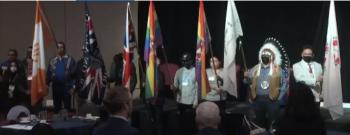Image Caption
Local Journalism Initiative Reporter
Windspeaker.com
Speaking with a single voice is the only way long-term reforms to funding, programs and services will become a priority with the federal government, say leaders of First Nations in Canada’s north.
“We need to shift the paradigm to look at more needs-based funding … so the discrimination cannot persist,” said Bobby Narcisse, deputy grand chief with the Nishnawbe Aski Nation (NAN).
Narcisse and Vice-Chief David Pratt with the Federation of Sovereign Indigenous Nations co-hosted the inaugural meeting of the National Assembly of Remote Communities (NARC) held May 31 to June 2 in Saskatoon.
The assembly was formed in 2021 through the global resolution negotiations in the agreements-in-principle that addressed outstanding claims against Canada for discrimination in the delivery of services for First Nations families and children on reserve. The result was a $40-billion settlement that included $20 billion in compensation and $20 billion to help reform child welfare in First Nation communities over five years.
Narcisse represents NAN at those child welfare negotiation tables.
Also at those tables is Manitoba Regional Chief Cindy Woodhouse, who represents the Assembly of First Nations. Woodhouse said the agreement “carves out” funding for NARC and outlines a NARC-specific process for long-term reform.
Woodhouse said the AFN fully supports the work undertaken by NARC and also fully supports the work undertaken by northern and remote communities who were not part of NARC.
The gathering brought together Nations from Ontario, Manitoba, Saskatchewan and the Northwest Territories who shared their lived experiences of being northern and remote and the challenges and barriers they faced.
There were numerous intersections: the high cost of living; the high cost of fuel; poor infrastructure, including housing and water; inability to get services; inability to attract and retain qualified professionals; and funding for child welfare, health and education programs and services that didn’t take into account the true cost of delivery in a northern and remote setting.
“Many of our communities within the remote north sit on very resource rich lands…Our communities, our children, youth and families should be enjoying a quality of life that is exceeding what they’re doing right now. The discrimination against our children and youth still persists,” said Narcisse.
Indigenous Services Canada Minister Patty Hajdu addressed the group virtually on the first day of the gathering.
“The work that you’re doing right now is so critical. This is, I think, a historic moment where… people are coming together in unity that are often separated by enormous distance. But not just distance, by the inequities that create constant crisis. One of the factors is… inequity in funding, but there’s also the crisis of challenges related to the remoteness itself,” said Hajdu.
She acknowledged the role colonization played in moving First Nations, some multiple times, to northern and remote locations and “less desirable land.”
“Discriminatory polices and underfunding means remote communities have not had the same opportunities,” said Hajdu.
She said the difficulties had been compounded by “jurisdictional squabbling” by the different levels of government to offload responsibilities.
Hajdu said the agreement-in-principle for remoteness funding will see Canada index funding to account for the increased costs.
“The indexing will apply to baseline funding and to additional top-up funding,” she said. “We’ll collaborate with First Nations to develop a methodology to account for remoteness cost on a national basis, building on the remoteness quotient adjustment factor methodology developed by the NAN-Canada remoteness quotient table.”
The concept of a remoteness quotient was introduced by NAN more than five years ago during the child welfare proceedings initiated by First Nations Child & Family Caring Society against Canada, which went before the Canadian Human Rights Tribunal. An agreement for the creation of the remoteness quotient table was signed by NAN and the federal government in 2017.
Hajdu also said the federal government will fully fund a NARC-Canada remoteness table to develop a First Nations evidence-based statistical model to “better understand and estimate the increased costs associated with remoteness” especially when it comes to delivering child and family services.
The federal government will also fully fund a NAN-Canada remoteness secretariate, said Hajdu, which will collect and analyze data and act as a best-practises hub for sharing tools and research.
Canada will also continue to fund Choose Life, a NAN program that promotes the mental, emotional and behavioural well-being of youth. The program will be fully funded under Jordan’s Principle at the current funding level until the child welfare settlement agreement is in place and then NAN and the federal government will agree on long-term funding, said Hajdu.
NAN Grand Chief Derek Fox said the work that was being undertaken by NARC was important.
“I know many of our people are relying on us to ensure we get this work done. And unity is extremely hard to break, extremely hard to break when it comes to working with First Nations people. The government will have a hard time in working with united nations, united First Nations … and I think we ensure that we keep that bond strong and I think this is one of those things that will help us move forward in child and family services and, of course, other areas,” said Fox.
Local Journalism Initiative Reporters are supported by a financial contribution made by the Government of Canada.

